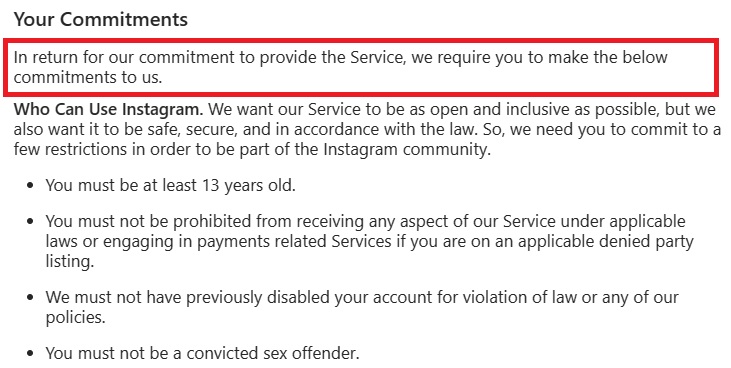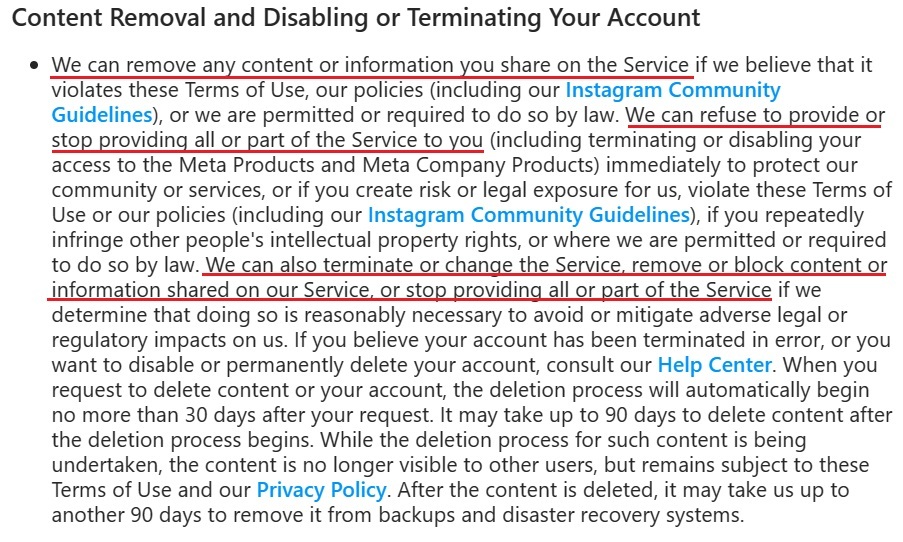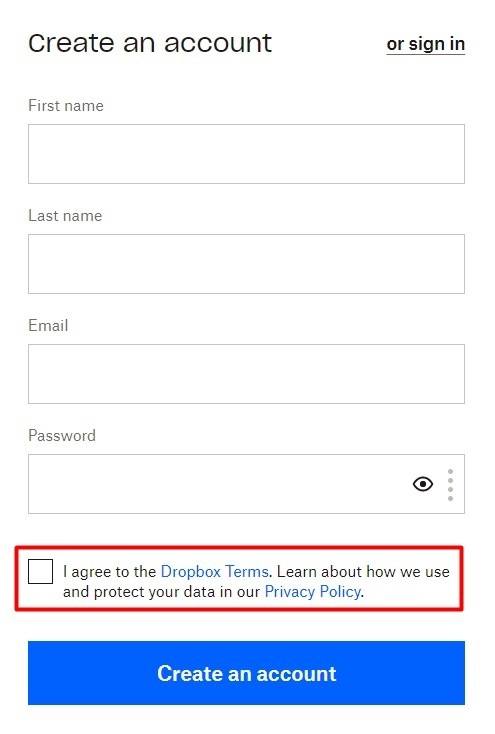Terms & Conditions for User-Generated Content
When people discuss your business online, they're making user-generated content (UGC) that drives audience awareness and brand recognition. Establishing clear guidelines for UGC lets you realize its marketing benefits while limiting legal liability.
A solid Terms and Conditions agreement shields your website/app and protects your users from the impact of issues such as inappropriate conduct, intellectual property lawsuits and copyright concerns.
What is a Terms and Conditions Agreement?
A Terms and Conditions agreement is a legal document that outlines the rules, regulations, rights and responsibilities that govern the use of your app or website.
Users of your site or service must agree to the Terms and Conditions before creating and sharing posts, photos, reviews or other types of UGC.
What is User-Generated Content?
User-generated content includes material created by online visitors to your app or website. This term encompasses text, images, videos, comments, reviews and other content about your brand. Forum discussions, testimonials, social media posts and product reviews also constitute UGC.
Sponsored posts and other paid partnerships don't count as UGC - this type of content is created for free.
Most UGC consists of visual content such as live streams, videos and images. For example, a customer could share an unboxing live-stream featuring products from your latest line, a video about how to use your service or a photo of your item in their space.
Fans of your brand might post selfies from company-sponsored events or brick-and-mortar locations. You'll see countless examples like the post below from the Instagram page:

Adding the #starbucks hashtag automatically shows off this type of post on the brand's "tagged" tab, which you can see in the second screenshot:

Ratings and reviews represent another common category of UGC. They give consumers a simple but effective way to interact with your brand by sharing their thoughts on a platform like Google. Users may also create blog posts, articles and podcasts discussing your products and services.
You can easily repurpose both visual content and written UGC for your marketing campaigns and social pages. Consider showing off a five-star overall customer rating on your social feeds or highlighting customer reviews directly on product pages.
How Can Your Business Benefit From User-Generated Content?
Your business can benefit from UGC by leveraging this valuable content in your marketing assets. Consumers tend to trust reviews from other users more than paid promotions. These testimonials serve as social proof that others have been satisfied with your brand's products or services.
Successful use of UGC also builds your customer base. Research by PowerReviews shows that conversions increase by 8.5% over the industry average when consumers see your UGC in their feeds. This metric more than doubles for users who respond to or share reviews of your brand.
UGC can also serve as the foundation of an active online community. When fans of your brand connect with one another through your website or app, the increased engagement will boost both awareness and available revenue.
Many companies find they can spend less on paid promotions with an effective UGC strategy. You'll free up more of your marketing budget to diversify your communication channels and expand your target audience.
Why Do You Need a Terms and Conditions Agreement to Publish User-Generated Content?
You don't legally need a Terms and Conditions agreement to publish user-generated content. However, this agreement provides important benefits and protections related to UGC.
Let's consider some of the key advantages of a solid T&C agreement for UGC.
Control and Management
A well-crafted Terms and Conditions agreement gives you control over UGC, allowing you to manage your brand's online presence effectively. You can uphold the platform's quality and integrity by preventing issues such as spam, privacy concerns and offensive language.
Terms and Conditions agreements also protect your access to third-party services like Instagram, Google Play and the Apple App Store. These platforms remove brands that fail to manage and remove objectionable content under their own Terms agreements.
In addition, Apple's App Store refuses to accept apps that don't meet its requirements for UGC. When you submit an app for review by Apple, you must show that you require users to sign T&C and have a way to filter inappropriate content. You also need to incorporate a way for users of the platform to block contact and content from abusive users. Finally, you have to respond within 24 hours when a user reports inappropriate content on your app.
Legal Protection
Terms and Conditions agreements provide legal protection from disputes about ownership of content, licensing and intellectual property rights. The agreement also can limit your liability for issues created by UGC. In other words, a user can't sue you because another user made a misleading post about your product.
Creating a Terms and Conditions agreement reduces your risk of involvement in a copyright infringement or defamation lawsuit. If you share a user-created post without permission and it generates profit, the original creator could sue you for that revenue. You can avoid this situation with a clause that gives your brand broad permission to share and publish UGC.
Account Sanctions
Account sanctions clauses in Terms and Conditions agreements let you take action against users who violate your terms. Include a clause that outlines the types of unacceptable content and behavior, including but not limited to obscene language, hate speech and harassment.
Clearly state the penalties for violating the Terms and Conditions agreement, such as removal of inappropriate content, suspension from the website/app and account termination.
Brand Reputation
A comprehensive Terms and Conditions agreement demonstrates professionalism and transparency, establishing a positive brand reputation. This legal agreement instills trust and confidence in your users, advertisers and potential partners.
How Do You Create a Terms and Conditions Agreement for User-Generated Content?
Use this guide to create a comprehensive Terms and Conditions agreement for user-generated content and see which clauses are best for a Terms agreement. Example screenshots from the Instagram Terms show how the company handles user-generated content.
Introduction
A brief introduction orients the reader to your Terms and Conditions agreement. It gives them information about the scope of the document and defines terms they might not know, such as user-generated content.
Here's how Instagram's Terms introduction gives users the purpose of the terms of use right away:

The introduction also covers basic information about your business. Include the company name, a brief description of your products and services, and names of partner organizations or subsidiaries.
Ownership and Licensing of Content
This section documents ownership of UGC posted on your website or app, and details the rights of each party. You can use your Terms and Conditions agreement to establish the right to reproduce, modify and publicly display content in promotion and operation.
For example, the Terms and Conditions agreement may state that you can license and distribute UGC while the original owner retains ownership, as seen here:

Consider crediting the original creator when you share UGC, even when you have license to share. Direct interaction with your brand drives engagement, which encourages users to return to your website/app. The credit line also clearly identifies a publication or post as UGC, distinguishing it from brand-created content.
User Responsibilities and Guidelines
Your Terms and Conditions agreement should also outline the responsibilities of users for the content they create and share on the website/app. Common requirements include complying with community guidelines and respecting the rights of others.
Instagram refers to this section as "Your Commitments," highlighting the obligation users have while on the app:

Establish clear guidelines for acceptable content and behaviors on the website/app. Use the Terms and Conditions agreement to prohibit illegal, harmful or offensive content such as hate speech, harassment and pornography.
It is common to prohibit UGC that does any of the following:
- Promotes self-harm
- Shows nudity
- Sells illegal products or services
- Includes graphic violence
- Threatens public or personal safety
- Constitutes harassment or hate speech
Intellectual Property Rights
Address issues related to intellectual property rights, including copyright, trademarks, and moral rights. Specify that users are responsible for obtaining any necessary permissions or licenses for content they upload.
Here's how this can be addressed:

Limitation of Liability
A limitation of liability clause prevents users from suing your platform if their posts damage their business reputation or cost them money. Without this clause, someone could claim you have legal liability for their UGC.
Instagram's Terms includes a clause that broadly limits legal liability to no more than $100:

Privacy
Including a privacy clause will show that your website/app takes measures to protect private user information. You can link to your complete Privacy Policy in this clause.
Here's how Instagram does this:

Account Termination
An account termination clause outlines the circumstances under which user accounts may be terminated or content may be removed from the website/app, such as violations of the Terms and Conditions agreement or repeated infringement of intellectual property rights.
This type of clause helps discourage lawsuits from terminated users. It also allows you to remove IP-infringing content immediately without fear of legal repercussions.
Instagram's Terms incorporates a long list of reasons for account sanctions up to and including termination:

How Do You Display and Get Agreement for a Terms and Conditions Agreement for User-Generated Content?
Once you've drafted your Terms and Conditions agreement for UGC, make it easily accessible and readable for users. Consider these best practices.
Post the Terms and Conditions agreement link in prominent locations on your website or app. It should appear in the header or footer of your website, on the registration or sign-up page, and within user account settings.
Sephora presents a link to the Terms every time users sign in to their accounts:

Here's how a Terms and Conditions agreement link can be displayed in a website footer:

To get users to agree, implement an "I Agree" checkbox on your registration or sign-up page that users must check before proceeding. This serves as evidence that users have read and agreed to the Terms and Conditions agreement before using the website/app.
Here's an example:

Summary
When used effectively, UGC can accelerate brand recognition, reputation and revenue. With this guide, you can create a comprehensive Terms and Conditions agreement for UGC that shields your brand from potential legal and financial repercussions.
Make sure to include information on who owns the rights to the UGC, what types of UGC is not allowed, what actions will be taken against account holders who violate your terms, and clauses that help to limit your legal liability.
Display your Terms and Conditions for UGC in your site's footer, on an account sign-up and sign-in page, and make sure users click a box to show they are consenting to be bound by the terms.